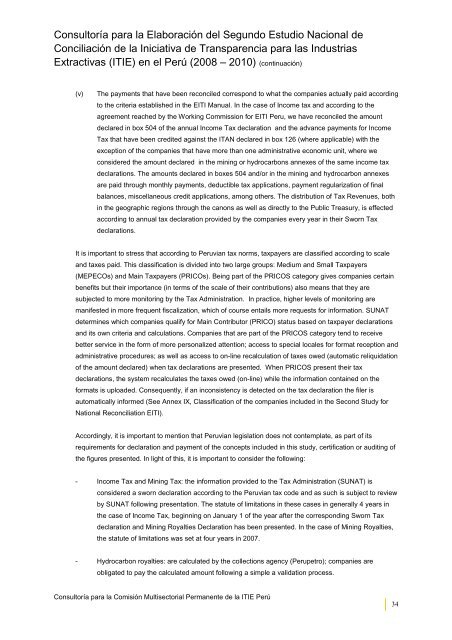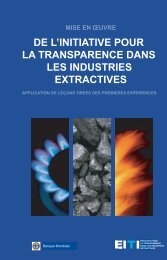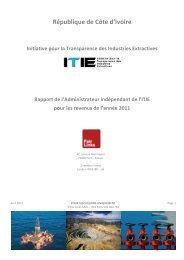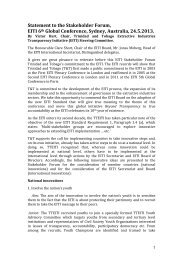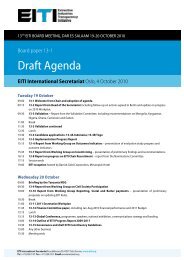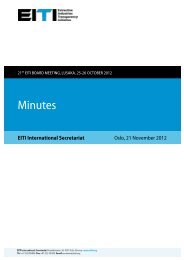Second National Reconcilation Study EITI Peru - unofficial…
Second National Reconcilation Study EITI Peru - unofficial…
Second National Reconcilation Study EITI Peru - unofficial…
Create successful ePaper yourself
Turn your PDF publications into a flip-book with our unique Google optimized e-Paper software.
Consultoría para la Elaboración del Segundo Estudio Nacional de<br />
Conciliación de la Iniciativa de Transparencia para las Industrias<br />
Extractivas (ITIE) en el Perú (2008 – 2010) (continuación)<br />
(v) The payments that have been reconciled correspond to what the companies actually paid according<br />
to the criteria established in the <strong>EITI</strong> Manual. In the case of Income tax and according to the<br />
agreement reached by the Working Commission for <strong>EITI</strong> <strong>Peru</strong>, we have reconciled the amount<br />
declared in box 504 of the annual Income Tax declaration and the advance payments for Income<br />
Tax that have been credited against the ITAN declared in box 126 (where applicable) with the<br />
exception of the companies that have more than one administrative economic unit, where we<br />
considered the amount declared in the mining or hydrocarbons annexes of the same income tax<br />
declarations. The amounts declared in boxes 504 and/or in the mining and hydrocarbon annexes<br />
are paid through monthly payments, deductible tax applications, payment regularization of final<br />
balances, miscellaneous credit applications, among others. The distribution of Tax Revenues, both<br />
in the geographic regions through the canons as well as directly to the Public Treasury, is effected<br />
according to annual tax declaration provided by the companies every year in their Sworn Tax<br />
declarations.<br />
It is important to stress that according to <strong>Peru</strong>vian tax norms, taxpayers are classified according to scale<br />
and taxes paid. This classification is divided into two large groups: Medium and Small Taxpayers<br />
(MEPECOs) and Main Taxpayers (PRICOs). Being part of the PRICOS category gives companies certain<br />
benefits but their importance (in terms of the scale of their contributions) also means that they are<br />
subjected to more monitoring by the Tax Administration. In practice, higher levels of monitoring are<br />
manifested in more frequent fiscalization, which of course entails more requests for information. SUNAT<br />
determines which companies qualify for Main Contributor (PRICO) status based on taxpayer declarations<br />
and its own criteria and calculations. Companies that are part of the PRICOS category tend to receive<br />
better service in the form of more personalized attention; access to special locales for format reception and<br />
administrative procedures; as well as access to on-line recalculation of taxes owed (automatic reliquidation<br />
of the amount declared) when tax declarations are presented. When PRICOS present their tax<br />
declarations, the system recalculates the taxes owed (on-line) while the information contained on the<br />
formats is uploaded. Consequently, if an inconsistency is detected on the tax declaration the filer is<br />
automatically informed (See Annex IX, Classification of the companies included in the <strong>Second</strong> <strong>Study</strong> for<br />
<strong>National</strong> Reconciliation <strong>EITI</strong>).<br />
Accordingly, it is important to mention that <strong>Peru</strong>vian legislation does not contemplate, as part of its<br />
requirements for declaration and payment of the concepts included in this study, certification or auditing of<br />
the figures presented. In light of this, it is important to consider the following:<br />
- Income Tax and Mining Tax: the information provided to the Tax Administration (SUNAT) is<br />
considered a sworn declaration according to the <strong>Peru</strong>vian tax code and as such is subject to review<br />
by SUNAT following presentation. The statute of limitations in these cases in generally 4 years in<br />
the case of Income Tax, beginning on January 1 of the year after the corresponding Sworn Tax<br />
declaration and Mining Royalties Declaration has been presented. In the case of Mining Royalties,<br />
the statute of limitations was set at four years in 2007.<br />
- Hydrocarbon royalties: are calculated by the collections agency (<strong>Peru</strong>petro); companies are<br />
obligated to pay the calculated amount following a simple a validation process.<br />
Consultoría para la Comisión Multisectorial Permanente de la ITIE Perú<br />
34


